Getting Started
So you’re interested in getting started making a scroll. Good decision! Here are a few suggested steps to consider when planning out your scrolls.
Steps to Making a Scroll
Currently, we do not commission every scroll given out. Parchment accepts scrolls from the general scribal community with spaces for names and dates to be filled in whenever the scroll is chosen to give out to a recipient. The only fully commissioned scrolls are Chivalry, Masters of Defense, Laurel, Pelican, Patent of Arms, Rose, County, Duchy, Augmentation of Arms, and Chalice (although a Chalice scroll may or may not be given with the award as it is an order of humility; it is the only award that doesn’t typically receive a scroll). Scribes are usually approached by the Parchment Office or the recipient to commission these scrolls. If you have a special interest in doing one of these scrolls, please contact your Principal Parchment Officer.
- Accept commission/determine project
- Decide on the size closely based on the exemplar (see common frame sizes below)
- Choose period, place, and appropriate style
- Plan out margins
- Sketch out illustrations design and under drawing
- Lay calligraphy guidelines with light pencil markings
- Write calligraphy
- Rubricate (elaborate, typically red, capital letters or other decorations)
- Gild
- Paint
- Sign your work on back of scroll list media used (can use subtle maker’s mark in the illustration as well)
- Store finished scroll in a flat space. Transport it using a scroll cozy (2 pieces of flat cardboard taped together and covered in fabric).
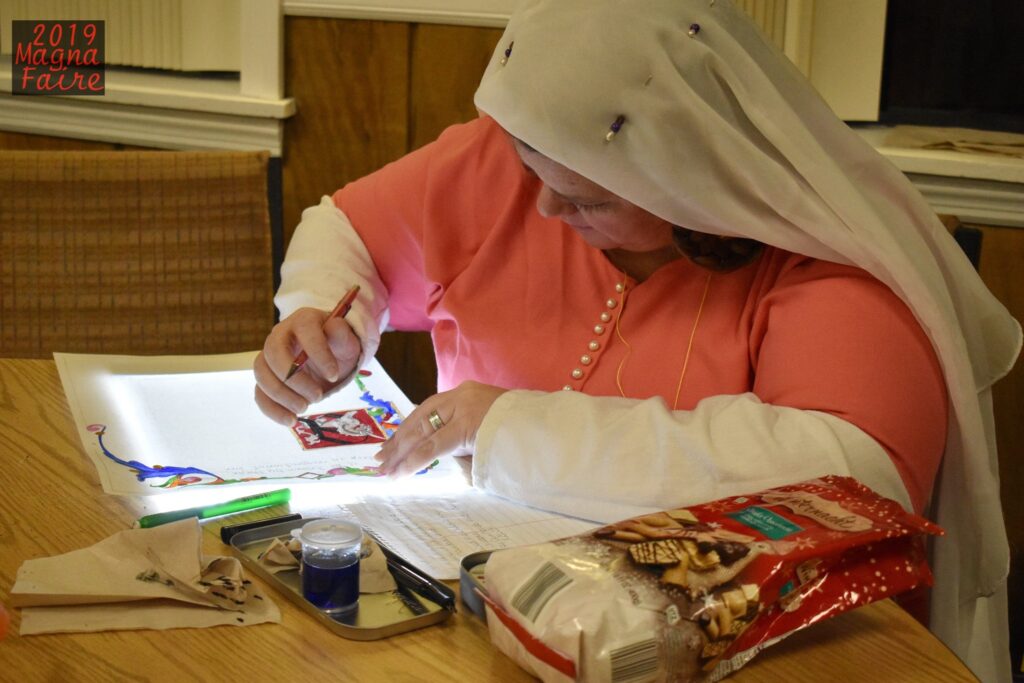
Common Tools Used in Calligraphy and Illumination
Supplies
Listed below are tools commonly used in making scrolls to consider purchasing. We wil go into further depth on some of these supples
- Table Slant
- Lightbox
- Paper
- Tools for layout and design
- Rulers
- T-square
- Ames Lettering Guides
- Templates (Circle, Square, Shield, Stars)
- Drafting tape
- Pencils
- Erasers
- White polymer eraser
- Kneaded eraser
- Gum eraser
- Tools for Painting
- Palettes
- Paints
- Pipettes
- Pigment liners/Micron
- Clear and wash water containers
- Brushes
- Tools for Calligraphy
- Nibs
- Nib holders
- Ink
- Inkwell
- Pen knife
- Xacto knife
- Burnisher
- Tools For Gilding
- Gesso
- Gold
- Gilding Knife
- Glassine
- Burnisher
- Straw
- Gilding Brush
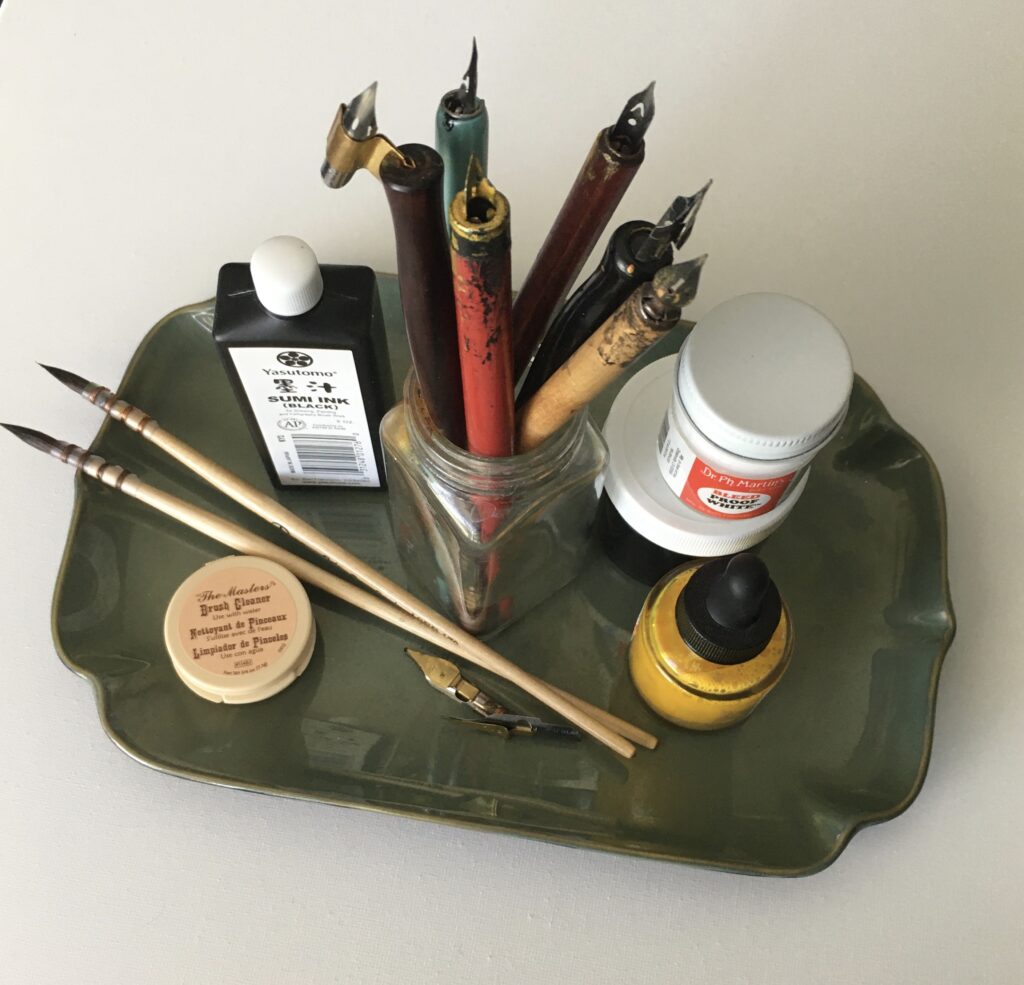
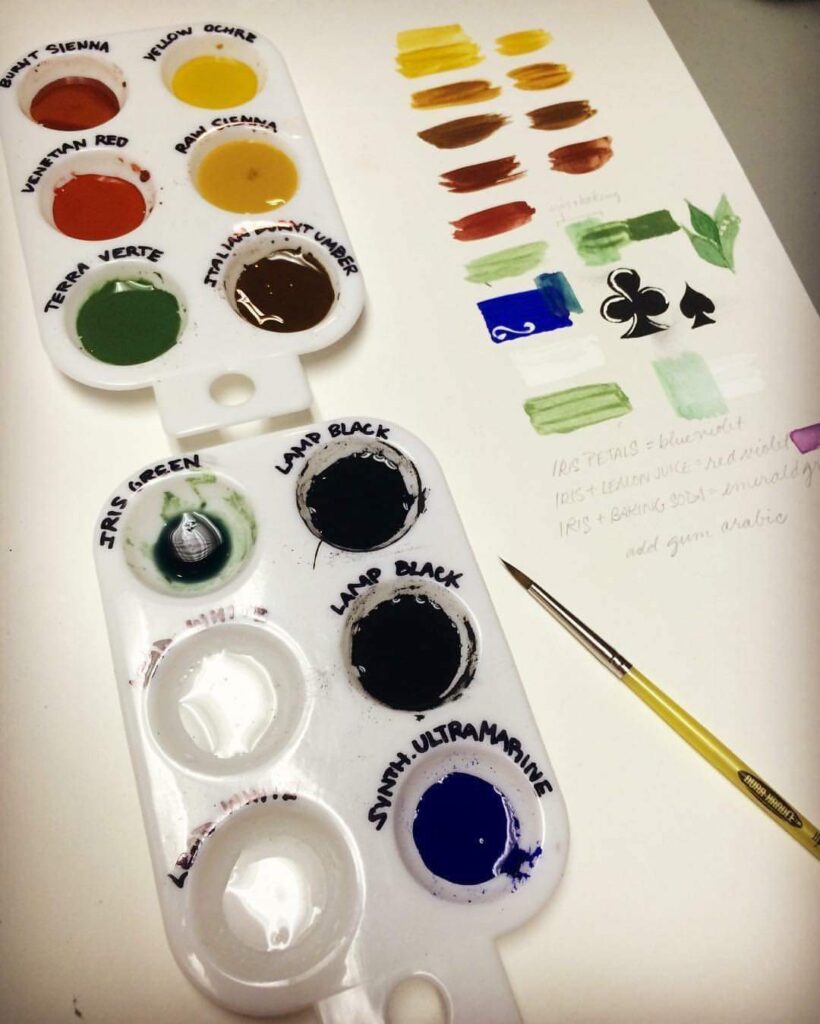
Paper/Ground/Support:
Support or Ground basically just means the substrate or what we commonly call “Paper” the illumination is painted on. And these, Listed below are the “papers” most commonly used in our Kingdom.

Bristol (smooth/hot-pressed) is a smooth support that holds its shape well. It responds to watercolor, bodycolor, and ink very well. Wet mediums get absorbed by the paper slightly which makes scraping off mistakes slightly more difficult and tricky but not impossible. Bristol also comes in vellum surface which is a little bumpier than smooth which makes it slightly difficult to get real crisp, clean calligraphy. This being said, scrolls done in vellum surface will not be turned away.(300 is standard, but 400 and 500 series can also be used–they’re just nicer and more expensive; can also be found at Michaels).

Pergamenata is an italian machine-made paper (by Fedrigoni) with ECF pulp translucent 100% sulphite, neutral pH laminated by natural starches. This us a reasonable cost effective substitute for parchment. It has a close look and similar working properties as parchment. It comes primarily in two thicknesses: 160 g/m² and 230 g/m². The 230 is much heavier and more suited to scrolls. It can be purchased in large sheets (shipped rolled-up) or pre-cut in 11”x14” 8″x11.5″, and 5″x7″ sheets. This can be purchased from John Neal Books, Pergamina, Paper & Ink Arts, or Amazon. Because of the nature of Pergamenata it is best to use a dry paint or body color gouache as overly wet or watercolor will curl and buckle the paper. Also hand oils will sit on top of the paper and can effect the paint and ink. Make sure to use gloves or wash hands before handling Pergamenata or use a scrap paper between you hand and the Perg as you paint. Mistakes are easy to scrape off as the paint and ink sits on the surface of the paper.

Paper – There are many different types of acid free papers out there made from wood pulp, cotton pulp or linen pulp. It is recommended to buy a small amount to try before committing to a large purchase. Some papers may be better for paint and some may be better for calligraphy or gold. Try to find one that works for all aspects of a scroll and something that works for you. Many companies produce suitable papers. the more prominent ones including Arches, Stonehenge, Lans, Rives, Strathmore, Fedrigoni, and Fabrino (which has made paper since the Middle Ages).
**Please do not use cardstock. If using watercolor paper as cold pressed please notate on the back as this type of paper is too bumpy to successfully render calligraphy. Also watch out for the term vellum and parchment as modern paper makers like to use those terms but they don’t mean what they used to and they can become brittle and discolored with age.**
Medieval Support:



Parchment or vellum is made from processed animal skin specifically made for books and manuscripts. As this is a lengthy and time consuming process usually done by hand, parchment can be cost prohibitive but also the most period and most desirable to work with. Mistakes can be scraped off easily like butter.
Papyrus was used in the Mediterranean in the early middle ages until 11th c. It was commonly used in rolled scrolls of varying length for documents
Birch Bark was used throughout period written with a blunt stylus to crease the surface. It was rolled or bound in codices
Paper is period and became popular in later period during the renaissance. It was typically made from linen fibers. Although in China, Rice Paper was used much sooner than elsewhere in Europe. It is very delicate and difficult to work with.
Pencils:
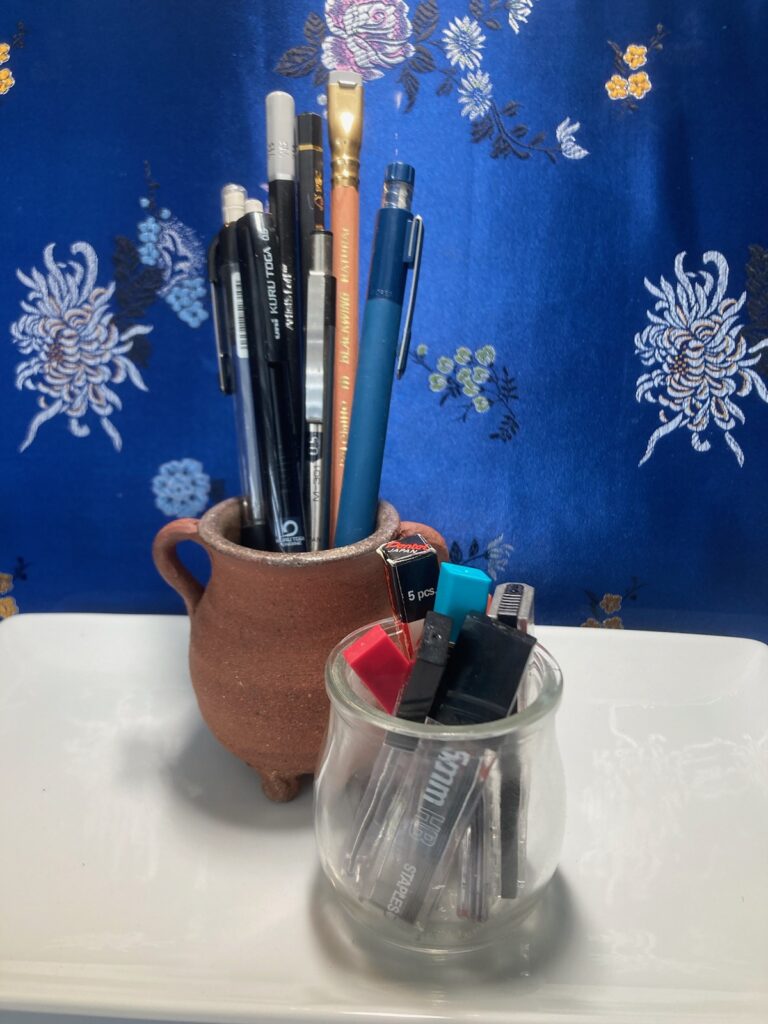
You want a pencil that makes light smooth marks on the paper. Hard pencils need more pressure to leave a mark and can crease the surface whereas soft pencils can leave too dark a line that is hard to completely erase and may show up under some of your paint especially whites, red, and yellows. A 2H pencil is a good compromise. Though if you use HB pencil make sure to press lightly.
Mechanical pencils are great too because they don’t have to be sharpened. A 0.5 lead mechanical pencil leaves a light enough mark without gouging the surface. Also something to consider but harder to find in brick and mortar stores is a 0.3 lead pencil. The lead is so thin that it forces you to have a light hand else the lead will break. It makes very fine and light lines that you don’t have to worry about the markings showing up under paint.
*Please do not use markers, gel pens, or crayons as they in no way resemble period materials and will usually fade. Though pigment liners, like Micron, are acceptable to use in illumination please do NOT use them in calligraphy.*
Pens:
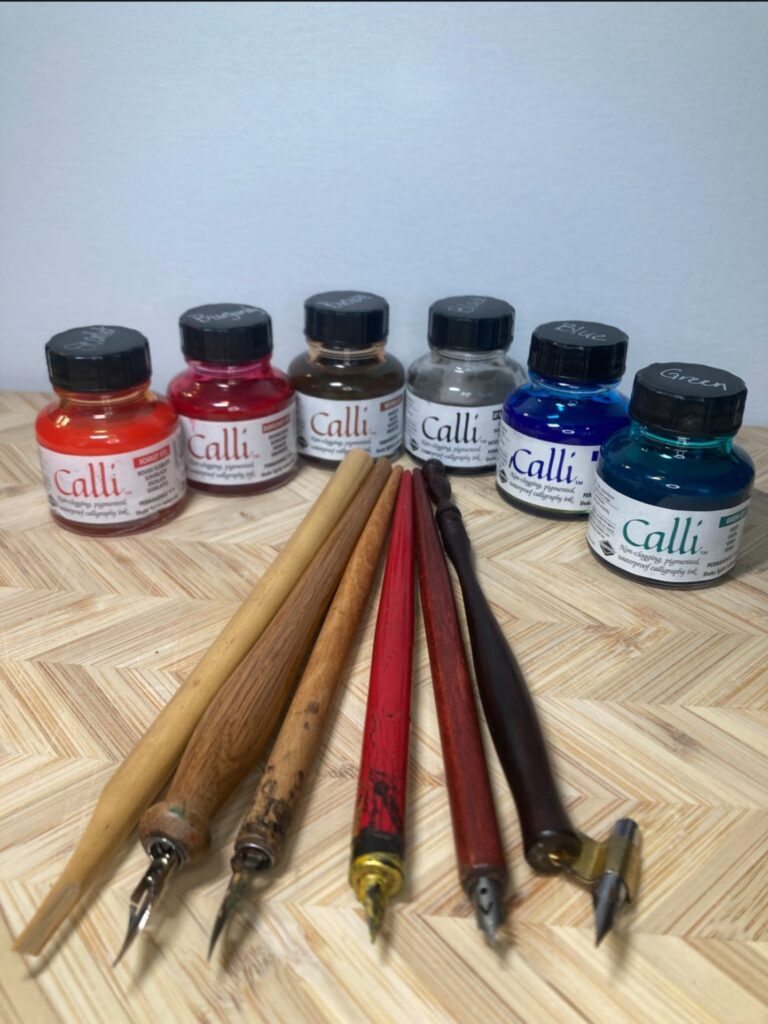
Calligraphy nibs come in many different sizes. Medieval script tends to be quite small except for in regards to choir books. ¾ mm to 1 mm works well for an 8.5 x 11 scroll. For smaller works a ½ mm nib may be needed. Often new nibs come with a coating on it to prevent rusting but it also can hinder ink flow. To remove this coating hold it over a lighter and then squelch it in cool water which helps keep the metal springy.
Nibs can come with reservoirs to hold more ink so the pen doesn’t need to be dipped as often. There are above and below the nib reservoirs that can be removable or permanently attached.
Clean the pen with water and dry it after every use, then store in a dry space to prevent rusting.
Fountain pens may be used but keep in mind the type of ink used. A non-waterproof india ink resembles a period lamp black ink and is a good substitute. Acrylic ink may have a higher chance of flaking off in the cases or clogging the nib like glue. Also be aware of colorfastness of ink since colored ink has a tendency to fade over time. (See ink section below for period ink recipes). Some fountain pens let you refill ink cartridges and some people have taken to filling them with a period ink like Oak Gall Ink.
Pigment Liners/Microns are a tool often used to outline the work with a smooth solid line. These are acid free and archival and are not markers.
Natural Pens are made from the hollow tube of a reed or primary feathers of geese, turkeys, swans, etc. They give extra fine detail and need the barest of pressure to write. They do take some effort to maintain and cut. (See cutting Quills section)
Brushes:
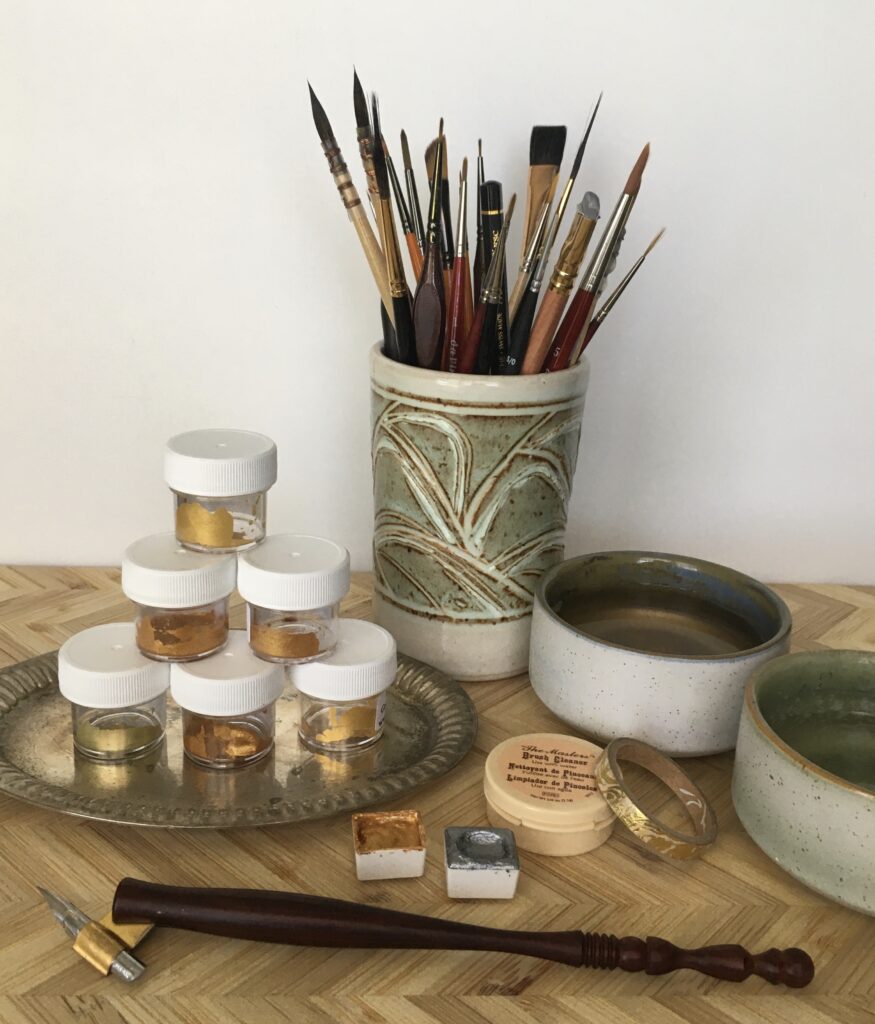
Watercolor brushes are made out of synthetic material that can be used with gouache and watercolor. The hold their shape well and have a good spring back. These brushes come in different grades: Student, Artist, and Professional.
Sable brushes are made out of Siberian weasel hair and though they may be considered the gold standard of brushes, not all sable brushes are created equal and extensive research should be given in choosing this type of brush.
The most important attributes to look for when choosing a brush are the tip shape, the charge or amount of paint it can hold, ability to retain shape when wet, and the ability to spring back to its original shape.
Brushes have many different shaped heads. Round brushes are used most commonly but there are also angled brushes, mop, liner, knife, fan, and many others. The heads of a brush can make different shaped strokes on the paper and if used as intended can help the artist achieve a specific stroke.
Brushes come in many different sizes. When choosing a size brush choose “the biggest brush that will work for the job.” A 0000 size brush holds very little paint and would run out before making much of a line and doesn’t give much bristle flexibility. A straight line would become choppy and feathery. To the contrary, using a large brush has the risk of leaving such wet paint that it may buckle the paper. Water control when painting can help prevent this from happening but often times the type of support chosen can mitigate or exacerbate this issue. Parchment and pergamenata are better with drier paint methods to prevent buckling and curling. Once buckling happens it can be sandwiched between heavy books to flatten back out or taped/stapled down prior to painting can prevent buckling.
Drafting Tools:
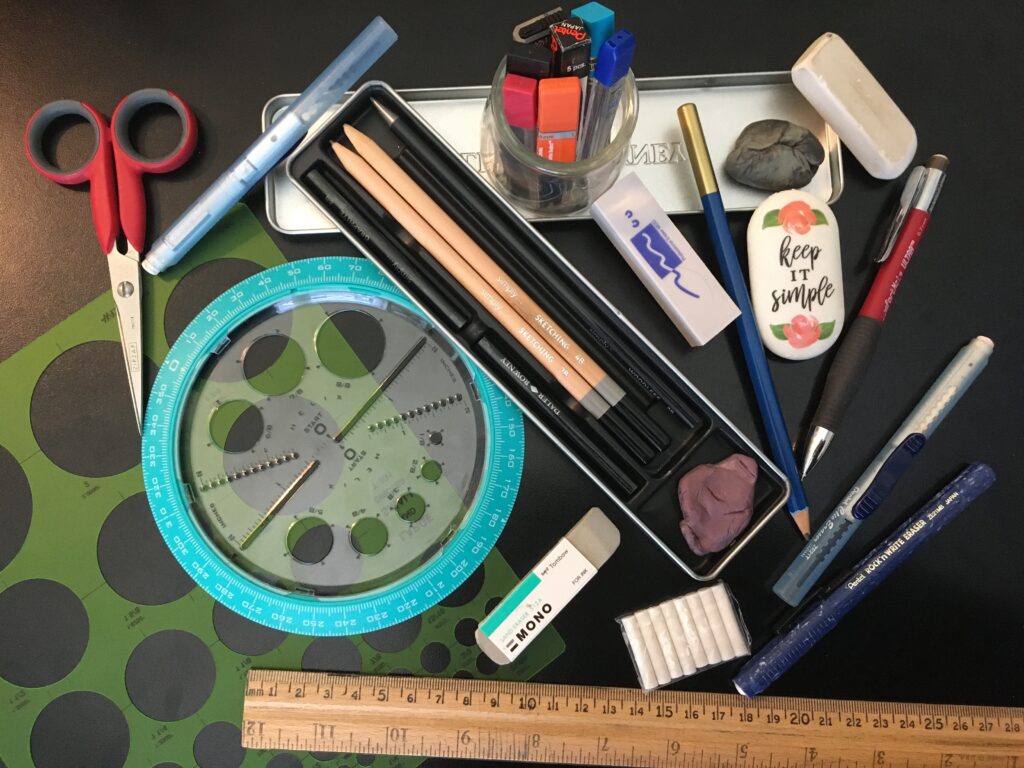
These are helpful when laying out guide lines, margins, calligraphy lines. A ruler, triangle, T-square, and an ames lettering guide will be helpful for drafting calligraphy lines. A protractor, and templates (circles, squares, shields) will be helpful for quick shapes that need to be consistent. Drafting tape or painter’s tape can be useful to secure the support to a board to keep it from buckling or for areas that you don’t want to get paint on, like margins.
Pigment Liner/Micron:

To outline your art, please make sure to use archival black lining markers. Micron pens are the standard, though there are others. Never use Sharpie. Also, after painting, don’t be afraid to touch up the line work with your micron again.
